Roger Brucker
Beneath the Surface
By Fred Anderson
As a child, Roger Brucker was fascinated with the unknown, always curious to discover what amazing things existed beyond his backyard boundaries.
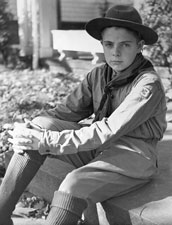
Boy Scout Roger Brucker,
age 12 |
He writes in Beyond Mammoth Cave, at age four "I climbed over a board fence to discover a world of giant rocks among whose dark recesses I crept. I had found the hidden place! Within minutes, an adult head appeared over the top of the fence. I don't remember the words, but the message was clear: Don't you ever do that again! Of course, I paid no attention at all."
Cavers everywhere are grateful for Roger's tenacity, for it was that determination that later paved the way for some of the greatest discoveries in one of the world's greatest caves.
Roger was born on July 27, 1929 in Shelby, Ohio. He developed an early interest in caves when he discovered that he could hide in closets behind the hanging clothes and nobody could find him. He built his own "caves" out of card tables, chairs, and blankets. He first visited real caves at Put-in-Bay, Ohio at age 5. Finally, when his mother took him on the all day trip at Mammoth Cave at age 8, he was hooked.
Caving was not the only pursuit that piqued Roger's interest at an early age. His first literary success came in high school, when he won a trip to Washington, DC in an American Legion essay contest. He credits his Aunt Margaretta Brucker with inspiring him to become a writer.
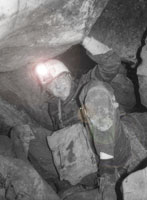 "Aunt Retta wrote about a dozen mystery and romance books," says Roger. "She wrote about a chapter a day on a portable typewriter on yellow paper. I always wanted to be like her."
"Aunt Retta wrote about a dozen mystery and romance books," says Roger. "She wrote about a chapter a day on a portable typewriter on yellow paper. I always wanted to be like her."
After completing high school in his hometown, Roger went on to earn a BA in the Practice of Art at Oberlin College in 1951. Shortly thereafter, he entered the U.S. Air Force and was stationed at Wright-Patterson AFB near Dayton, Ohio. His job was writing and directing documentary, technical, and training films. While in the Air Force, Roger became friends with an aerial photography officer named Richard Watson. The two would spend many years caving together, and would eventually co-author The Longest Cave.
 When he wasn't producing training films for the Air Force or working on ad campaigns for a local advertising agency, Roger spent every available weekend exploring caves near Mammoth Cave National Park in Kentucky. In 1954, he was recruited to participate in a week-long expedition in Floyd Collins' Crystal Cave which, at that time, was still privately owned. Roger told the story of the so-called C-3 Expedition in his first book The Caves Beyond, co-authored by expedition leader Joe Lawrence Jr.
When he wasn't producing training films for the Air Force or working on ad campaigns for a local advertising agency, Roger spent every available weekend exploring caves near Mammoth Cave National Park in Kentucky. In 1954, he was recruited to participate in a week-long expedition in Floyd Collins' Crystal Cave which, at that time, was still privately owned. Roger told the story of the so-called C-3 Expedition in his first book The Caves Beyond, co-authored by expedition leader Joe Lawrence Jr.
 Convinced that Crystal Cave would one day connect with caves in nearby Mammoth Cave National Park, Roger and other explorers formed the Cave Research Foundation. CRF negotiated with the National Park
Service for permission to explore and survey caves in the park. CRF remains active today in Mammoth Cave National Park, Carlsbad Caverns National Park, Sequoia-Kings Canyon National Park, Buffalo Scenic River, Lava Beds National Monument, and other study areas, including caves in China.
Convinced that Crystal Cave would one day connect with caves in nearby Mammoth Cave National Park, Roger and other explorers formed the Cave Research Foundation. CRF negotiated with the National Park
Service for permission to explore and survey caves in the park. CRF remains active today in Mammoth Cave National Park, Carlsbad Caverns National Park, Sequoia-Kings Canyon National Park, Buffalo Scenic River, Lava Beds National Monument, and other study areas, including caves in China.
 In the late 1950s and 60s, under the leadership of Roger Brucker and others, CRF expanded the known reaches of Flint Ridge caves and discovered connections between many of the other large caves in the park. In 1972, cavers found a connection between Mammoth Cave and the Flint Ridge Cave System. This historic discovery made Mammoth the world's longest cave, inspiring Roger Brucker and Richard Watson to publish The Longest Cave in 1976.
In the late 1950s and 60s, under the leadership of Roger Brucker and others, CRF expanded the known reaches of Flint Ridge caves and discovered connections between many of the other large caves in the park. In 1972, cavers found a connection between Mammoth Cave and the Flint Ridge Cave System. This historic discovery made Mammoth the world's longest cave, inspiring Roger Brucker and Richard Watson to publish The Longest Cave in 1976.
 Following the Flint-Mammoth connection in 1972, Roger remained active in cave exploration, while at the same time devoting more attention to professional and educational pursuits. In 1972, he was promoted to president of the advertising agency where he had worked since the early 1950s. In 1975, he became an adjunct professor at Wright State University, teaching marketing classes part-time. Throughout the 1970s, 80s and 90s, Roger wrote many articles for professional, academic and scientific publications, and gave lectures on subjects ranging from advertising to cave exploration.
Following the Flint-Mammoth connection in 1972, Roger remained active in cave exploration, while at the same time devoting more attention to professional and educational pursuits. In 1972, he was promoted to president of the advertising agency where he had worked since the early 1950s. In 1975, he became an adjunct professor at Wright State University, teaching marketing classes part-time. Throughout the 1970s, 80s and 90s, Roger wrote many articles for professional, academic and scientific publications, and gave lectures on subjects ranging from advertising to cave exploration.

Floyd Collins,1924
Photo by Wade Highbaugh
|
In 1976, following publication of The Longest Cave, Roger began working on the book Trapped! The Story of Floyd Collins. Like many other people, Roger had long been fascinated with the Floyd Collins tragedy, but was frustrated with retelling the story repeatedly from inadequate sources. Collaborating with historian Robert K. Murray, Roger meticulously researched the life of Floyd Collins. In the process, he interviewed dozens of witnesses and studied hundreds of documents to uncover new facts about the failed effort to save the trapped caver's life. Roger even ventured into Sand Cave several times to the very spot where Floyd Collins was trapped, to better understand why rescuers could not get him out.
"It was one of the most frightening experiences of my life," Roger says.
"Unlike most caves, Sand Cave is extremely unstable. The rocks in the walls
and ceiling are loose and crumbling. It's easy to see how rescuers crawling
back-and-forth so many times caused it to collapse."
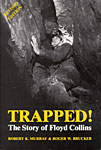 Trapped! was published in 1979, and became an instant success. Sixteen years later, the book would be the inspiration for the innovative stage musical Floyd Collins by playwright Tina Landau and composer Adam Guettel.
Trapped! was published in 1979, and became an instant success. Sixteen years later, the book would be the inspiration for the innovative stage musical Floyd Collins by playwright Tina Landau and composer Adam Guettel.

Robert Murray and Roger Brucker at Floyd's tomb in Crystal Cave. Floyd's body has since been buried in a nearby cemetery. |
Ms. Landau has referred to Roger's book as her "bible" during the time that she wrote the play. Unquestionably, Trapped! remains the most accurate, most thoroughly researched account of the Floyd Collins tragedy ever written.
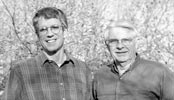
James Borden & Roger Brucker
|
In the mid-1970s Roger met a teenager from Maryland named James Borden. At that time James was a bright, ambitious, but relatively inexperienced caver who wanted to help explore Mammoth Cave. After a short stint with CRF, James formed his own organization, the Central Kentucky Karst Coalition, to find and explore caves outside of Mammoth Cave National Park. CKKC spent the next few years exploring Roppel Cave, pushing it closer to Mammoth Cave while, at the same time, Roger and CRF were pushing Mammoth Cave closer to Roppel.
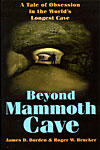 In 1983, a connection was found between the two caves, expanding Mammoth Cave at that time to 300 miles in length (it is now more than 365 miles long). Before this connection was discovered, there was deep mistrust between CRF and CKKC. In an effort to protect what they perceived to be their "territories," the two groups went to great lengths to keep secrets from each other. After the Mammoth-Roppel connection was found, however, James Borden and Roger Brucker put past rivalries behind them to collaborate on Beyond Mammoth Cave: A Tale of Obsession in the World's Longest Cave. It took Roger and Jim 17 years to finish writing the book, but most readers agree that it was worth the wait!
In 1983, a connection was found between the two caves, expanding Mammoth Cave at that time to 300 miles in length (it is now more than 365 miles long). Before this connection was discovered, there was deep mistrust between CRF and CKKC. In an effort to protect what they perceived to be their "territories," the two groups went to great lengths to keep secrets from each other. After the Mammoth-Roppel connection was found, however, James Borden and Roger Brucker put past rivalries behind them to collaborate on Beyond Mammoth Cave: A Tale of Obsession in the World's Longest Cave. It took Roger and Jim 17 years to finish writing the book, but most readers agree that it was worth the wait!
During the 1980s, between other writing projects and caving expeditions, Roger began researching a subject that had long fascinated him--the life of Stephen Bishop. 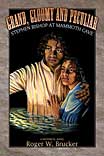 Bishop was a slave who gained fame as a guide and explorer at Mammoth Cave from 1838 until his untimely death in 1857.
Bishop was a slave who gained fame as a guide and explorer at Mammoth Cave from 1838 until his untimely death in 1857.
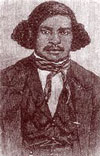
Stephen Bishop |
He pushed farther into the cave than anyone ever had at that time, and was responsible for many important discoveries. However, few records exist that offer many details about Bishop, so Roger concentrated his research on slave history in Kentucky, in order to accurately describe the circumstances in which Bishop lived. Roger broke away from his tradition of writing nonfiction, to write the story as a historical novel. The result was Grand, Gloomy, and Peculiar: Stephen Bishop at Mammoth Cave, which was published in October, 2009. Although it is fiction, the novel does not alter any known historical or cultural facts. Roger asked several experts in African American slave history to read his manuscript and offer their comments. All of them praised the book. Donald Murphy, CEO and president of the National Underground Railroad Freedom Center, even called Grand, Gloomy, and Peculiar "one of the best historical novels I have ever read."
Although retired from the ad agency where he spent most of his professional life, Roger remains more active than many people half his age.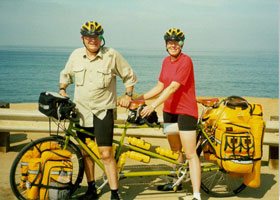 When not crawling around underground, he is occupied with a variety of business and educational projects. He works as a marketing consultant for several clients. He is a co-founder of, and is active with, Karst Environmental Education and Protection, a non-profit organization dedicated to the preservation of land containing sinkholes and caves. He is also nearing completion of his fifth book, an historical novel based on the true story of Stephen Bishop, a slave-guide at Mammoth Cave from 1838 to 1857.
When not crawling around underground, he is occupied with a variety of business and educational projects. He works as a marketing consultant for several clients. He is a co-founder of, and is active with, Karst Environmental Education and Protection, a non-profit organization dedicated to the preservation of land containing sinkholes and caves. He is also nearing completion of his fifth book, an historical novel based on the true story of Stephen Bishop, a slave-guide at Mammoth Cave from 1838 to 1857.
Roger has four grown children from a previous marriage. He has been married to Lynn Brucker since 1983. They are avid bicycle travel enthusiasts who, in 2000, rode their tandem bicycle 3,200 miles from San Diego, California to St. Augustine, Florida. In 2003, they rode from Dayton, Ohio to Kittyhawk, North Carolina. In 2004 they rode from Dayton to Bar Harbor, Maine. And in 2006, they rode from Washington, DC to Pittsburgh. Roger and Lynn are also kite flyers and agility dog trainers with four Standard Poodles. Roger draws cartoons and illustrations for books on caves, dog training, and bicycling.
He still goes caving.

